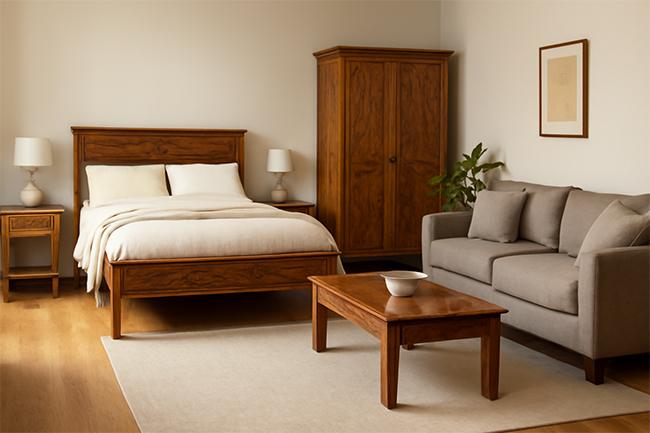Tiger Oak, valuable and highly unique type of oak wood, distinguished by its striking grain pattern created through a special cutting technique known as quarter-sawing.
Today, it remains a sought-after material for high-quality furniture and flooring, with its value continuing to rise due to its rarity and timeless charm.
Whether in antique form or modern pieces, Tiger Oak offers both lasting beauty and exceptional functionality, making it a valuable choice in today’s market.
Quarter-Sawn Cutting and Visual Appeal
In quarter-sawn oak, the wood growth rings are angled in comparison to the edges of the wood board. This results in a more prominent grain pattern and medullary rays, which appear like “stripes” or “flecks.”
This cutting technique enhances the visual appeal of the wood, giving it a unique and attractive appearance.
Unique “Tiger Stripes” Pattern
The technique brings out a beautiful “tiger stripes” pattern in the wood, making it stand out from other types of wood.
This distinctive feature adds to its visual attraction, setting it apart from more traditional wood types.
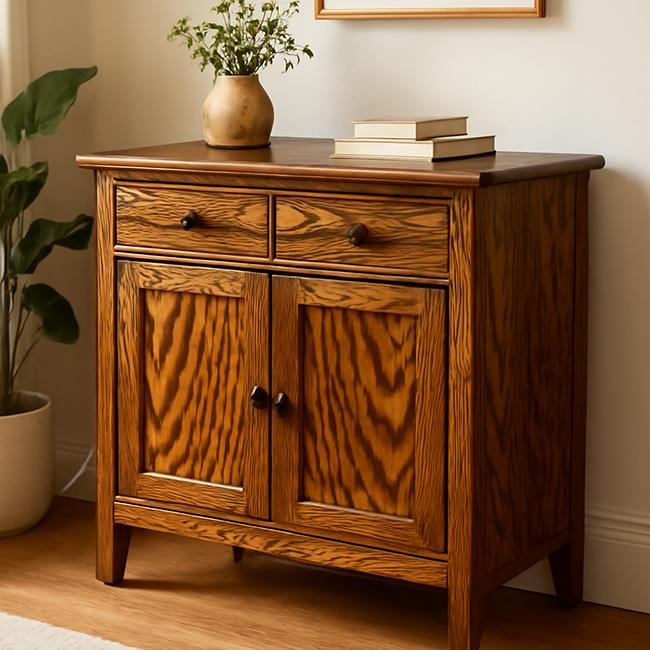
Strength, Stability, and Durability
The most notable features of Tiger Oak are its strength, stability, and unique grain pattern design. Quarter-sawn oak is more stable, experiencing less warping or twisting.
This stability arises because the wood slices are less affected by moisture and dryness. For this reason, Tiger Oak is ideal for both furniture and flooring, offering premium quality.
Is Tiger Oak Valuable Today?
Tiger Oak holds significant value, especially if it’s an antique piece from the 1800s or early 1900s. During that era, it was highly popular for royal furniture, cabinets, and tables.
The Timeless Appeal of Antique Tiger Oak
Even today, collectors and interior designers purchase these pieces at high prices, not just for their function but also because they represent craftsmanship and history.
However, the value of each piece depends on its condition, design, and the maker. If the wood retains its original polish and is free from damage, its price can increase further.
In simple terms, Tiger Oak is a valuable and collectible wood, known for its beauty and durability. It maintains steady demand in the antique furniture market and is considered a symbol of luxury and heritage.
Factors Affecting the Value of Tiger Oak Furniture
The value of Tiger Oak furniture depends on the following factors:
- Age: The older the piece, especially if it’s an antique (from the late 1800s to early 1900s), the higher its value—especially if the style has remained popular over time.
- Condition: Damage, repairs, veneer deterioration, or missing parts significantly impact the value. A piece with its original finish in good condition will always fetch a higher price.
- Craftsmanship or Maker: If the piece was created by a well-known furniture maker or brand, or features intricate carving and detailed design, its price can increase considerably.
- Rarity / Style Demand: Some designs and styles are more popular than others. If your Tiger Oak piece features a design that is currently in demand or has significant heritage value, both its demand and value will be higher.
- Material & Solid Wood vs. Veneer: Pieces made from solid oak, rather than just oak veneer, tend to have a much higher value. Veneer pieces are typically less valuable than their solid wood counterparts.
Factors Leading to a Decrease in Value of Tiger Oak Furniture
The value of Tiger Oak furniture can decrease due to the following factors:
- Trend Change: Sometimes, the demand for older “brown furniture” or heavy antique styles declines as trends evolve.
- Poor Finish or Extensive Repairs: If the finish is damaged or many repairs have been made, particularly if the original design or parts are missing, the value of the piece decreases.
- Shipping and Transport Costs: If the furniture is heavy and needs to be shipped to a different city or country, the high shipping costs can impact potential buyers and decision-makers.
Estimate / Market Trends
Tiger Oak furniture pieces can start at around $115, with well-crafted, ornate pieces from renowned makers potentially reaching over $50,000.
However, most average pieces typically range from the low hundreds to low thousands USD.
What Is The Difference Between Oak And Tiger Oak?
The difference between Oak and Tiger Oak is that Tiger Oak is cut using the quarter-sawn technique, which creates a striped, tiger-skin-like pattern.
While Oak has a simpler, uniform grain without this distinctive pattern. Both are strong and durable, but Tiger Oak is more decorative.
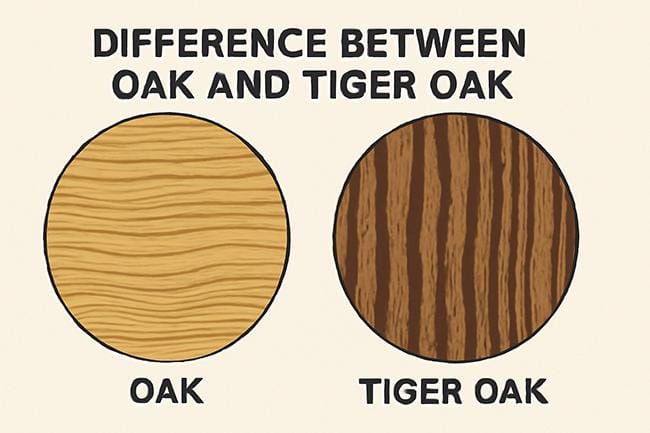
Oak: The Hardwood Tree
Oak is the name of a hardwood tree, known worldwide for its strength and beauty. This wood comes in various types, with the most famous being White Oak and Red Oak.
Both differ slightly in their color tones, texture, and durability, but they are both used for high-quality furniture and flooring.
Characteristics of Oak Wood
The grain of Oak wood, meaning its natural pattern, is straight, uniform, and smooth, giving furniture a classic and elegant look.
Oak wood is very strong, heavy, and long-lasting, which is why it is used in items like tables, cabinets, doors, and flooring.
Durability and Resistance
Oak wood is highly resistant to moisture and wear, making it a perfect combination of premium quality and durability.
This makes it ideal for furniture and construction that require both strength and aesthetic appeal.
Tiger Oak: A Unique Oak Wood
“Tiger Oak” is not a different tree; rather, it is a type of oak wood that is cut in a special way.
This cutting method is known as the quarter-sawn technique, in which the wood is sliced at an angle to the grain.
Quarter-Sawn Cutting Technique
This process causes the natural fibers and medullary rays present in the oak to rise to the surface, creating a striped or tiger-skin-like pattern. It is this distinctive and beautiful pattern that gives the wood its name, “Tiger Oak.”
Characteristics of Tiger Oak
Tiger Oak is known for its unique appearance, strength, and stability, making it a popular choice for high-quality furniture and antique pieces.
The striking pattern and durability make it highly valued in craftsmanship and design.
Simple Comparison Table:
| Feature | Oak | Tiger Oak |
| Type | Natural Oak Wood | Oak wood (quarter-sawn cut) |
| Pattern | Straight or slightly wavy grain | Striped/tiger-like pattern |
| Rarity | Common | Less common / decorative |
| Look | Simple, classic | Fancy, bold, antique look |
| Price | Normal | Usually more expensive (because of pattern & cutting style) |
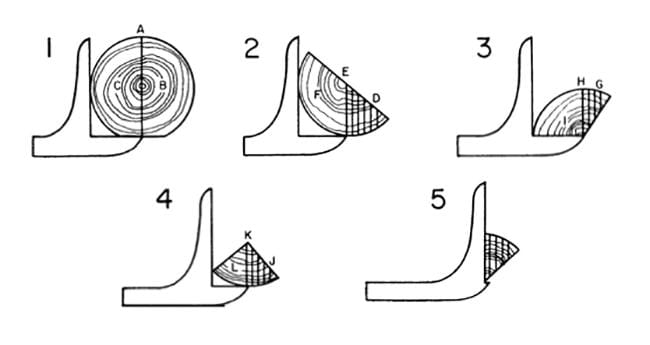
Quarter-Sawn Cutting Method
The quarter-sawn cutting method is a special technique used to cut oak wood, which results in Tiger Oak — a premium wood known for its beauty and quality.
In this process, the wood log is first divided into four equal parts (quarters), and then each quarter is cut at an angle to the grain, not straight.
This angled cutting brings out the natural fibers and medullary rays on the surface, creating a striped, tiger-skin-like pattern, which is why it’s called Tiger Oak.
This technique not only makes the wood strong and stable but also gives it an elegant, decorative appearance, making it a high-end choice for furniture and flooring.
Step-by-Step Process:
- Divide the wood log into 4 equal quarters.
- Cut each quarter at a perpendicular (around 90°) angle to the grain.
- The grain pattern of each slice will be straight and uniform.
- This process makes the wood strong, stable, and visually beautiful.
Quarter-Sawn vs Plain-Sawn (Normal Cut)
There are two common methods for cutting oak wood: plain-sawn and quarter-sawn. Both aim to create wood boards, but their cutting angles, appearance, and performance are quite different.
- Plain-Sawn Method: This is the most common and cost-effective method. The wood log is cut straight down the center, creating a curved, wave-like grain pattern. The advantage of this method is that it minimizes waste and speeds up production, but the downside is that the wood may warp or twist over time, especially when exposed to moisture.
- Quarter-Sawn Method: This is a more advanced and premium technique. The log is first divided into four equal quarters, and each quarter is cut at an angle (around 90°) to the grain. This results in a straight, uniform grain pattern with tiger-like stripes. Quarter-sawn wood is more stable, durable, and resistant to warping, but it takes more time and results in more wood waste, making it more expensive.
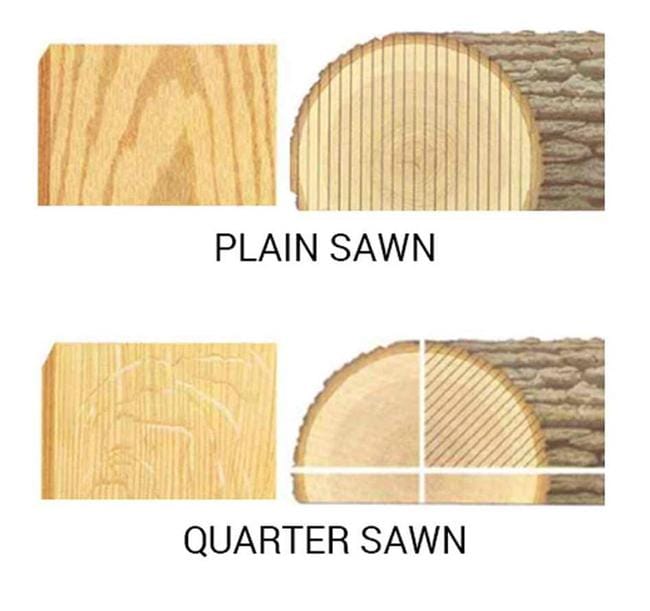
Plain-Sawn vs Quarter-Sawn (Quick Comparison)
| Feature | Plain-Sawn | Quarter-Sawn |
|---|---|---|
| Cutting direction | Straight through the center | Cut at an angle to the grain (≈90°) |
| Grain pattern | Wavy / curved lines | Straight lines + tiger-stripe figure |
| Stability | Can warp a bit | More stable, warp-resistant |
| Price | Cheaper | More expensive (more waste & time) |
| Look | Simple | Decorative / antique look |
Why Use the Quarter-Sawn Cutting Method?
The quarter-sawn cutting method is used because it makes the wood more stable, durable, and visually attractive.
- Stability: Wood cut this way is less likely to warp or twist, helping it maintain its shape for longer.
- Moisture Resistance: It is less affected by changes in moisture and temperature, reducing the chances of shrinking or cracking.
- Unique Grain Pattern: The cutting technique brings out a beautiful striped grain pattern on the surface, making the wood look premium and unique.
- Premium Look: This unique appearance gives furniture and flooring an antique and luxury feel, which is why this method is preferred for high-end woodworking.
Origin of the Quarter-Sawn Cutting Method
The quarter-sawn cutting method became popular in Europe during the 15th-16th century when craftsmen needed strong, stable, and moisture-resistant wood for cathedrals, castles, and royal furniture.
They discovered that cutting oak at a 90° angle (quarter-sawn) reduced warping and produced a more beautiful grain pattern.
Popularity in the Victorian Era
In the 1800s, Tiger Oak furniture gained luxury status in England and America, with quarter-sawn oak used for high-end pieces like tables and armoires.
Modern Use
Today, the method is still used in Europe, America, and Asia for high-quality furniture and flooring. While machine cutting has sped up the process, the basic principle remains unchanged.
Collective Discovery
The technique wasn’t invented by one person but was a collective discovery of carpenters and cabinet makers, especially in France and England, where it was first used to make oak beams and panels resistant to warping.
Why Is Quarter-Sawn Cutting Method Expensive?
- Complex Cutting Process
Normal (plain-sawn) wood is cut straight, saving time and wood.
In quarter-sawn, wood is cut at an angle, requiring more time, skill, and precision. The manual measuring and rotating increases labor costs. - More Wood Waste
When cutting into “quarters,” extra scrap wood is created between slices.
This results in fewer usable boards, making the process less efficient and more costly. - Extra Load on Machines and Tools
Quarter-sawn cutting requires slow speed and special alignment for blades and sawmills.
This reduces production speed, leading to higher cost per board. - Unique and Decorative Pattern
The tiger-like stripes (medullary rays) are natural and unique in every board, adding an aesthetic premium.
People are willing to pay more for this distinctive pattern. - Higher Stability and Quality
Quarter-sawn oak is less prone to warping, shrinking, or twisting, making it more durable over time.
Premium furniture makers charge more for this quality and longevity. - High Demand, Low Supply
Fewer manufacturers use this method due to its slow and expensive process.
With high demand and low supply, the economics make it more expensive.
Conclusion (In Short)
In summary, the difference between Oak and Tiger Oak lies primarily in the cutting method. While Oak wood is cut simply, Tiger Oak is created through the quarter-sawn technique, resulting in a unique, striped pattern known as tiger stripes.
This distinctive pattern enhances the wood’s visual appeal, making it highly sought after for its premium look.
Tiger Oak remains valuable today due to its superior strength, stability, and durability, making it a top choice for furniture and flooring that lasts for generations.
The wood’s resistance to warping and moisture further boosts its desirability in both modern and antique pieces.
The combination of its unique appearance and exceptional performance ensures that Tiger Oak continues to hold its value in the market, catering to those seeking luxury and long-lasting quality.

